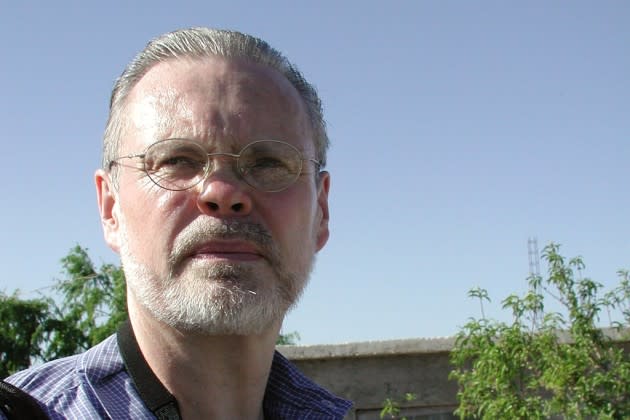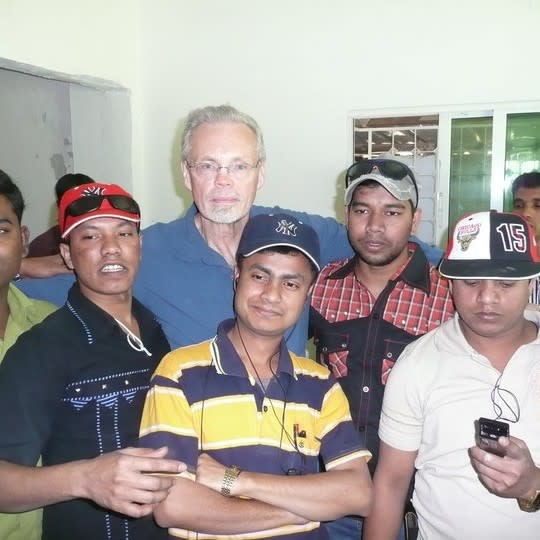Charles Kernaghan’s Lasting Legacy in Fashion

Fashion thrives on the power of big personality, people who intuitively understand how image and story can move mountains.
There are more than a handful of towering designers who have forever changed the industry with their eye and flair — although they did it from the inside and most often with million-dollar marketing budgets.
More from WWD
Sweatshop activist Charles Kernaghan changed fashion no less profoundly — and maybe corporate America as well — but from the outside.
And he did it with a lot of heart, a lot of grit and a very small budget.
Kernaghan died June 1 at the age of 74 after three decades of needling and shaming the fashion industry to be better by taking care of the people working in the factories, stitching together looks for famous brands.
His work and life trace a kind of arc through the modern fashion industry, the consumers’ consciousness and the activist community.
The current push in corporate America to pursue a purpose beyond profit — and the widespread embrace of environmental, social and governance concerns — required the hard work of many people from many different walks of life.
But it is impossible to think about today’s purpose-led environmental, social and corporate governance movement without first thinking about the effort to eliminate sweatshops.
In turn, it’s impossible to think about the sweatshop issue without its first poster child, the apparel industry.
And it was Kernaghan who forced the fashion sweatshop into the public dialogue.
Along the way he played a role in swaying the 1992 presidential election to Bill Clinton by exposing a U.S. government-funded program to outsource apparel jobs to Central America, rattled Kathie Lee Gifford for factory conditions and lit a fire under a generation of activists who are today carrying on the fight.
Kernaghan’s reputation within fashion morphed from that of rabble rouser who would cherry-pick cases of abuse to make a splash to a kind of better angel who arrived early and — however caustically — whispered in fashion’s ear that there was another way.
“He fostered immediate changes and was an enormous catalyst for continuous improvement in workers’ rights, a dynamic that the industry has embraced and which is driving today’s efforts to ensure forced labor does not taint our supply chains,” said Stephen Lamar, president and chief executive officer of the fashion industry trade group the American Apparel & Footwear Association.
“His contributions are going to be with us forever,” Lamar said. “He was one of the people who was early at pointing out problems. The creation of the whole social responsibility movement — that is definitely motivated by, inspired by a response to Charlie Kernaghan. Charlie Kernaghan had a positive, enduring impact and that impact is just continuing to grow.”
Kernaghan led the National Labor Committee, which was a foreign policy-minded wing of the U.S. labor movement, pushing from the inside to get unions to recognize and fight for the rights of workers overseas. Once peace accords in Central America signaled the end of the first phase of the organization’s work, Kernaghan took the operation independent in 1990.
Barbara Briggs, who was Kernaghan’s partner in the fight for fair play for nearly 30 years, said: “We had a really extensive Rolodex of contacts — labor and religious and advocacy contacts in the United States and also union and human rights leaders in then El Salvador, but beginning to expand in Guatemala and Honduras. It just seemed to us we had a level of trust and relationships we had built up, it was a shame to let all that go.
“What about these factories that are springing up? It might be a good idea to actually take a serious look at the conditions in those factories,” Briggs recalled their thinking at the time. “The union folks said to us, ‘It’s a bunch of little girls. Union people can’t get near the place.’ Essentially there was no contact being made with these workers, they were 16 years old.”
That was what set Kernaghan on a path that led him to an exposé of factory conditions with “60 Minutes,” presidential politics, high-profile campaigns targeting Gap, Kathie Lee Gifford’s Kellwood Co.-produced line at Walmart and much more.
A playbook developed that had Kernaghan finding factory workers that had endured horrible abuses and helping them tell their story, bringing them to Washington and beyond.
“This accusation of going after press was quite accurate,” Briggs said. “We did go after press because that is a very important way that information is spread and social dialogue takes place and so engaging on that level, which is something that we did quite purposefully, we did it because it was important for building the story and building support for the workers. God knows we didn’t make any money out of it.
“Instead of building an institution that would endure past Charlie, we stayed agile to fly through windows of opportunity when the right case, the right workers…we were not fettered and we were able to go after it to help,” she said.
And that’s what they did, zeroing in on conditions in Jordan in the 2000s, weighing in on production in Bangladesh, and keeping the pressure on under a new moniker, The Institute for Global Labour and Human Rights, and more.
“The apparel company executives hated our guts, but I think they also in some cases recognized that we drove them to do a better job.”
When Kernaghan first went after fashion companies, the default position among many of them was that the brands did not bear responsibility for what happened at the factories they used since they didn’t own them or directly employ the workers.
Now brands acknowledge that responsibility, have established codes of conduct and work with third-party monitoring groups.
The fight against sweatshops is surely not over — and might never be — but the pressure on companies is now moving up the supply chain, with brands starting to take on more responsibility, for instance in how the fibers that go into their goods are produced.
Does that mean that Kernaghan, who took on multibillion-dollar fashion companies while not sure where the next month’s rent would come from, ultimately won?
Briggs isn’t sure.
“I don’t know, I really don’t,” she said. “The fight goes on. Have factories become cleaner? I honestly don’t know. Do workers have the right to organize? I doubt it.”

Courtesy of Maryellen Kernaghan
Robbie Karp, a social impact adviser and cofounder of Karp Randel, has a different take.
Karp spent 22 years as a high-level executive at Liz Claiborne Inc., which has an enduring reputation as a socially minded company, but did take some heat from Kernaghan early on.
“He absolutely made a difference and he burnt some bridges, but who cares?” Karp said. “Winning seems like an all-or-nothing proposition. Yeah, they won. They improved lives.
“Where Charlie had an impact is governments and some shareholders and even officials within companies would say, ‘Wait a minute, is this us? Did we not see this issue? Is this really happening?’” Karp said.
“He was so damned efficient at telling the story, by bringing people forward,” she said. “He pulled at people’s sense of fairness.”
And many were changed by that.
Elizabeth Cline, apparel and labor rights activist and director of advocacy and policy at Remake, said: “I was a college student when the anti-sweatshop movement emerged in the late ’90s. Charles Kernaghan was in the middle of that and leading all that. If you were a young activist at the time, I was a teenager, he was a legend, an icon, larger than life. He was kind of this one-man band. He did a lot on his own, he carried a lot of weight on his shoulders to keep that movement going.
“He was a really good public speaker, he was a very charismatic, impassioned public speaker. He would use these really shocking anecdotes about your shirt dripping blood,” she said.
“He did play a larger role in unlocking that challenge of how to make a globalized industry feel…like it’s happening next store, that it could be your neighbor, your sister, your daughter. That really still is the playbook, it’s naming and shaming the companies because they’re the ones that have the power in the supply chain.…He left us in a promising place. You can’t get an MBA in this country without learning about what your wider responsibility is to the environment.”
Kernaghan’s sister, Maryellen Kernaghan, cites his impact on college students — who rallied against the use of sweatshops to make apparel sold by their schools — as a key part of his legacy.
“He was actually quite shy and actually quite quiet,” Kernaghan recalled. “So for him to get up there and to speak it was [not] the natural way that Charlie was, so it really took him to be completely focused on it. And then it did become second nature.
“Charlie worked on a shoestring budget,” she said. “He was just tenacious in his desire, what became a calling to help individuals who could not help themselves — and it wasn’t just to help them, it was to help them when they, in his eyes, were being stepped on by a big foot.
“Charlie worked seven days a week on this stuff,” she said. “He allowed himself very few indulgences. He led a very Spartan lifestyle. That Spartan lifestyle helped him to be able to put all of his energy and concentration on the work he was doing.”
Sign up for WWD's Newsletter. For the latest news, follow us on Twitter, Facebook, and Instagram.


